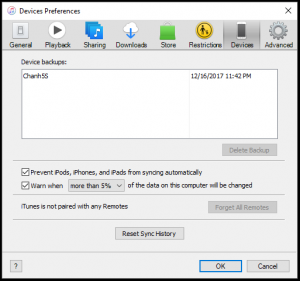My Windows laptop complains that there is very little free space left on the 128GB SSD drive. That’s strange because Windows 10 and the few applications I installed shouldn’t have taken that much space, maybe at most half the hard drive space. I dig around and find that my user’s hidden AppData directory is taking up 47GB!
Further investigation reveals that the culprit is “%APPDATA%\Apple Computer”, belonging to the Apples iTunes application. Specifically, iTunes’ device backup directory uses 34GB and software update directories use 12GB.
I use iTunes to backup and update several iPhones and iPads belonging to myself and different family members. Over the years, there have been many backups and many iOS versions. Because the base memory on the newer iPhone and iPad has increased (from 16GB to 32GB or higher), their backup images have grown in size (more songs, photos, and videos). Worse, iTunes does not automatically delete old iOS images that are no longer in use.
 Tip: Windows 10 (and probably Windows 8) includes a Systems Settings app called “Storage” that helps you to view and drill down into the space usage. Run it and select the drive to view how much space each file category is using. Click on the category to drill down further.
Tip: Windows 10 (and probably Windows 8) includes a Systems Settings app called “Storage” that helps you to view and drill down into the space usage. Run it and select the drive to view how much space each file category is using. Click on the category to drill down further.
Below are instructions on how to free up the drive space on Windows.
Delete Device Backups
To delete the backups using iTunes:
- Browse to menu “Edit->Preferences…”.
- Click on “Devices” (top-right icon).
- Select the unwanted backup listed under “Device backups:” and click “Delete Backup”.
Tip: Look for duplicate device backups to delete. Usually the device’s old backup is overwritten by the new backup; however, sometimes iTunes won’t overwrite and will create a new backup instead.
iTunes will move the deleted backups to the “%LOCALAPPDATA%\Temp” directory so you will want to clean up that directory manually or by using the free CCleaner tool. (Unfortunately, Windows’ built-in “Disk Cleanup” app does not empty the “%LOCALAPPDATA%\Temp” directory.)
Alternatively, you can manually delete all the backups using the command line:
cd "%APPDATA%\Apple Computer\MobileSync\Backup"
# Delete all subdirectories under device backup directory
for /d %d in (*) do rmdir /s %d
# You will be prompted to confirm deletion for each subdirectory.
# Note: We can pass a "/q" quiet flag to "rmdir" to not prompt, but that is dangerous!
Delete iOS Images
Delete the iOS images using the command line below. iTunes will download them again in the future if necessary.
cd "%APPDATA%\Apple Computer\iTunes\iPad Software Updates"
del *.ipsw
# Delete iPhone iOS images (ex: iPhone_4.0_64bit_10.3.1_14E304_Restore.ipsw)
cd "%APPDATA%\Apple Computer\iTunes\iPhone Software Updates"
del *.ipsw
# Delete iPod iOS images (ex: iPod4,1_6.1.6_10B500_Restore.ipsw)
cd "%APPDATA%\Apple Computer\iTunes\iPod Software Updates"
del *.ipsw
Note: iTunes 12.6.2 and earlier versions would also backup the apps, taking up more space than later versions. Later versions will re-download the apps from the App Store on the device when restoring.
If you use iTunes to backup and update iOS devices and find that your computer is running out of drive space, you may be suffering from the same issue that I have above. I hope that the above info will help you to slay your iTunes space hog.
Tip: Instructions are similar for Macs. Look in the “~/Library/Application Support/MobileSync/Backup” and “~/Library/iTunes” directories.
